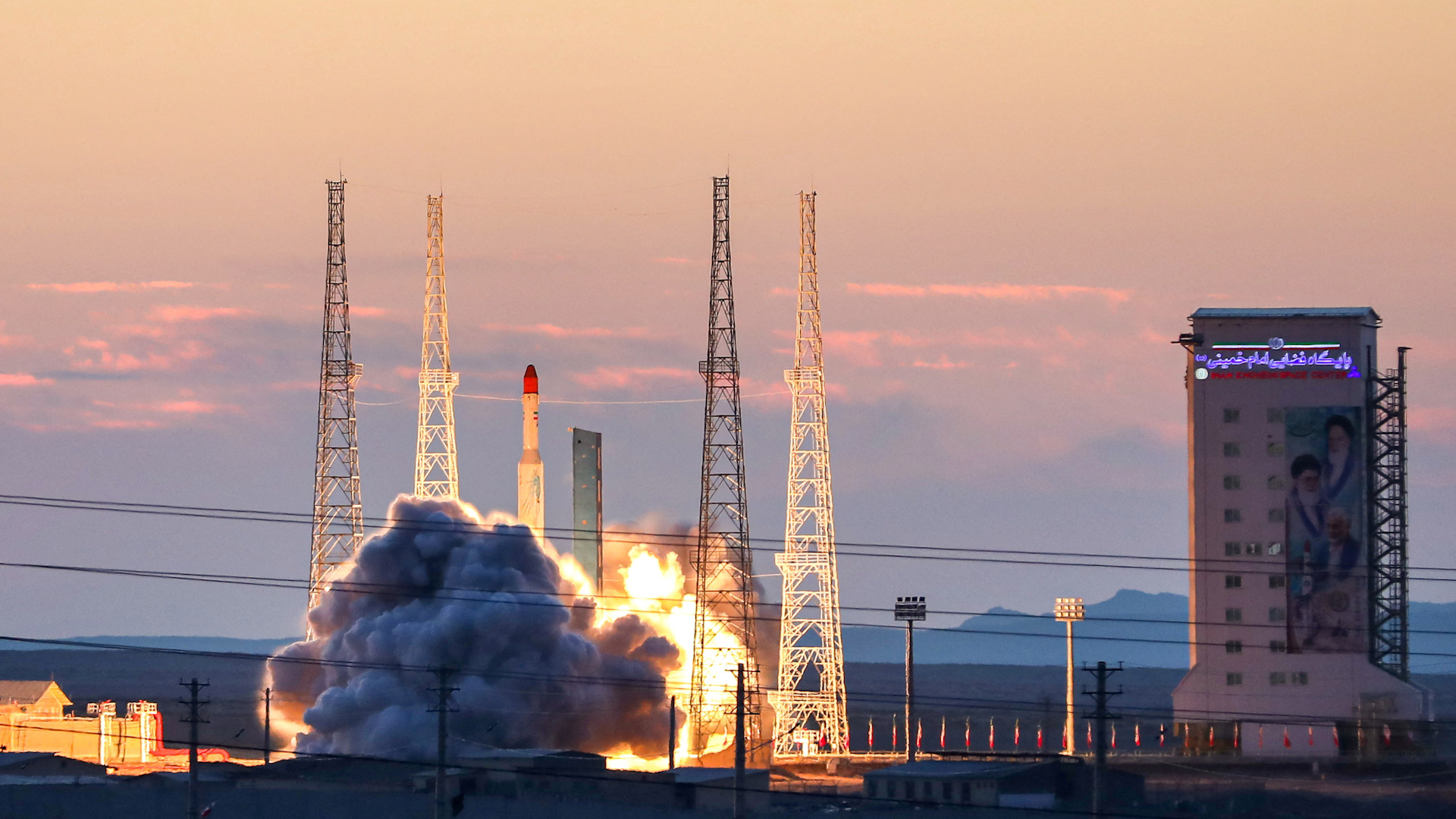
Tehran’s latest rocket launch sparks concerns over missile technology
By Lauren Taylor (Anchor), William Jackson (Producer), Bast Bramhall (Video Editor)
Iran successfully launched its heaviest satellite payload to date, the state-run IRNA news agency reported Friday, Dec. 6. The Simorgh rocket reportedly carried the Fakhr-1 satellite, named after assassinated nuclear scientist Mohsen Fakhrizadeh, along with an orbital propulsion system and research equipment.
Media Landscape
See how news outlets across the political spectrum are covering this story. Learn moreBias Distribution
Left
Right
Untracked Bias
State media claim the payload reached a 250 mile orbit, though independent verification is pending. The launch took place at the Imam Khomeini Spaceport in Semnan province, east of Tehran.
The moment Iran's"Fakhr 1" and "Saman 1" satellites were launched into space using Iran's home-made launcher Simorgh. pic.twitter.com/xJz5ePMVdL
— IRNA News Agency (@IrnaEnglish) December 6, 2024
The payload weighed approximately 660 pounds, marking the first known instance of Iran’s civilian space program carrying a military-related satellite. Iranian officials say the propulsion system could enable future satellites to achieve geo-synchronous orbits, a long-standing strategic goal.

Download the SAN app today to stay up-to-date with Unbiased. Straight Facts™.
Point phone camera here
The United States and its allies have raised concerns, warning that the technologies used in such launches could also advance ballistic missile development.
A 2023 U.S. intelligence report suggested that Iran’s space launch vehicles share technologies with intercontinental ballistic missiles, potentially accelerating Tehran’s ability to develop long-range weapons.
The launch comes amid heightened tensions in the Middle East, with conflicts in Gaza, Syria and Lebanon adding to regional instability. Iran’s nuclear program is also under scrutiny, as the International Atomic Energy Agency reports Tehran is enriching uranium to near weapons-grade levels using advanced centrifuges.
Iran maintains its nuclear and space programs are for peaceful purposes. However, restricted access for international inspectors and its advancing missile capabilities have fueled concerns.
The U.S. has previously stated that such satellite launches violate a now-expired U.N. Security Council resolution urging Tehran to refrain from developing ballistic missile technology.
President Masoud Pezeshkian’s administration has expressed interest in negotiating sanctions relief with Western nations, but for now, Tehran continues to push forward with space and nuclear projects.
[lauren taylor]
IRAN HAS LAUNCHED ITS HEAVIEST SATELLITE PAYLOAD YET, A MOVE STATE MEDIA CALLS A MILESTONE IN ITS SPACE PROGRAM. BUT WITH MILITARY TECHNOLOGY REPORTEDLY ONBOARD, THIS ROCKET LAUNCH IS RAISING QUESTIONS FAR BEYOND EARTH’S ORBIT.
TEHRAN ANNOUNCED THE SUCCESSFUL LAUNCH OF ITS HEAVIEST SATELLITE PAYLOAD CARRIED BY THE SIMORGH ROCKET. IT’S THE FIRST TIME IRAN’S CIVILIAN SPACE PROGRAM IS KNOWN TO HAVE DONE SO. STATE MEDIA CLAIM THE PAYLOAD REACHED ORBIT, THOUGH INDEPENDENT VERIFICATION IS PENDING.
THE ROCKET REPORTEDLY CARRIED THE FAKHR-1 SATELLITE, NAMED AFTER THE ASSASSINATED NUCLEAR SCIENTIST.
OFFICIALS SAY THE ROCKET’S ORBITAL PROPULSION SYSTEM COULD ENABLE GEO-SYNCHRONIZATION OF SATELLITE ORBITS—A LONG-STANDING STRATEGIC GOAL.
U.S. OFFICIALS WARN THAT TECHNOLOGIES USED IN SUCH LAUNCHES COULD ALSO AID BALLISTIC MISSILE DEVELOPMENT, POTENTIALLY ACCELERATING IRAN’S ABILITY TO PRODUCE INTERCONTINENTAL WEAPONS.
THESE DEVELOPMENTS COME AS TENSIONS ESCALATE IN THE MIDDLE EAST, WITH CONFLICTS IN GAZA, SYRIA, AND LEBANON COMPLICATING THE REGIONAL SECURITY LANDSCAPE. IRAN’S NUCLEAR ACTIVITIES ARE ALSO UNDER SCRUTINY.
MEANWHILE, SOMETHING WE’VE REPORTED ON BEFORE — THE INTERNATIONAL ATOMIC ENERGY AGENCY REPORTS TEHRAN IS ACTIVATING ADVANCED CENTRIFUGES TO PRODUCE NEAR WEAPONS-GRADE URANIUM. THE IAEA CHIEF DESCRIBED THIS AS A ‘DRAMATIC’ STEP, WARNING IT COULD SIGNIFICANTLY ENHANCE IRAN’S NUCLEAR CAPABILITIES.
TEHRAN INSISTS ITS NUCLEAR PROGRAM IS PEACEFUL, BUT RESTRICTED ACCESS FOR INSPECTORS HAS FUELED INTERNATIONAL CONCERN. IRAN’S REFORMIST PRESIDENT, MASOUD PEZESHKIAN, HAS EXPRESSED OPENNESS TO NEGOTIATING SANCTIONS RELIEF BUT CONTINUES TO PUSH AHEAD WITH THESE CONTROVERSIAL PROJECTS.
FOR MORE OF OUR UNBIASED, STRAIGHT FACT REPORTING – DOWNLOAD THE STRAIGHT ARROW NEWS APP TODAY, OR LOG ON TO SAN.COM.
Media Landscape
See how news outlets across the political spectrum are covering this story. Learn moreBias Distribution
Left
Right
Untracked Bias
Straight to your inbox.
By entering your email, you agree to the Terms & Conditions and acknowledge the Privacy Policy.
MOST POPULAR
-
 Getty Images
Getty Images
Democrats in Congress receive lowest approval rating in Quinnipiac poll history
Watch 2:5910 hrs ago -
 Getty Images
Getty Images
AG Bondi reviewing Epstein documents for release, could hold client list
Watch 1:4810 hrs ago -
 Getty Images
Getty Images
Speaker Johnson won’t support DOGE stimulus checks
Watch 2:0612 hrs ago -
 Reuters
Reuters
UN chief reveals his plan for peace in Haiti to Caribbean leaders
Watch 2:1513 hrs ago




